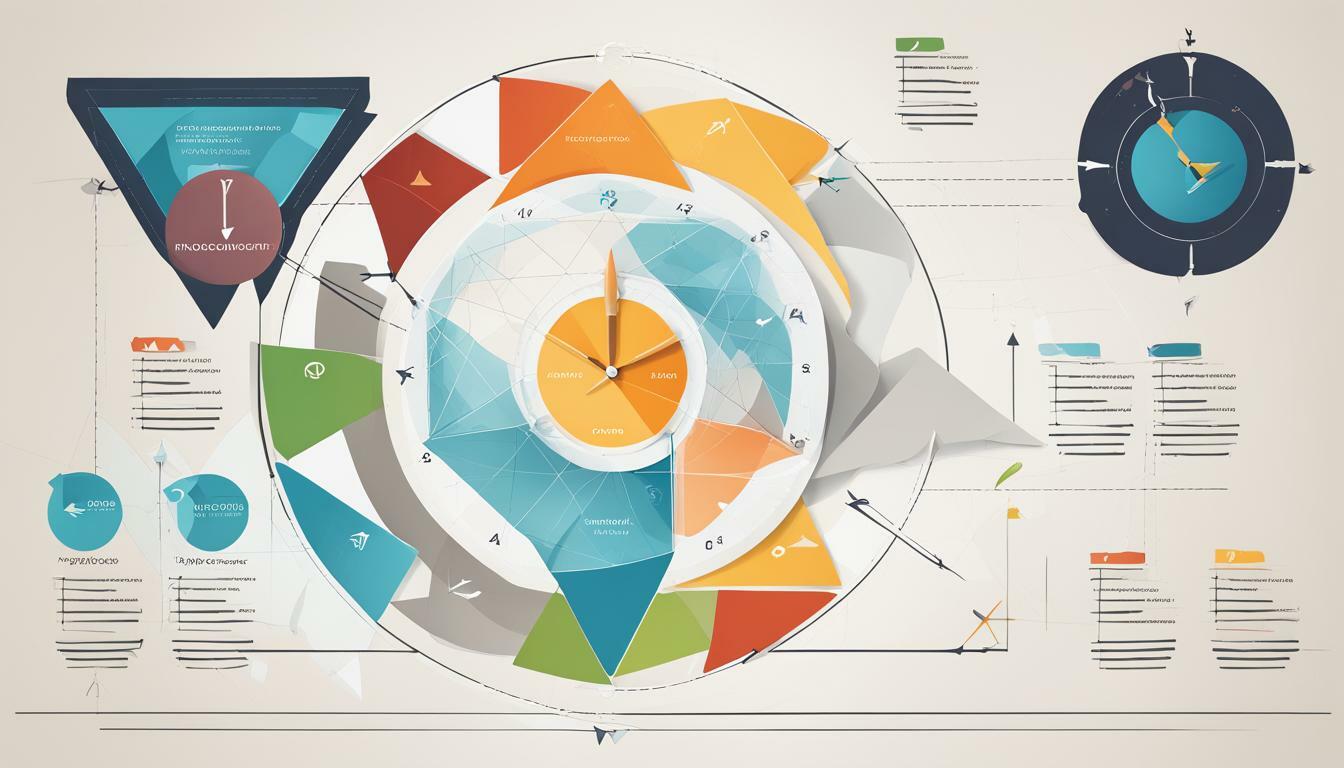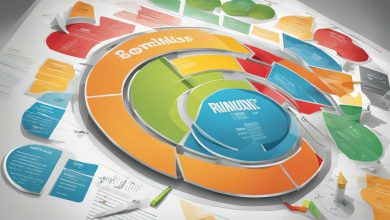
Project management is a complex process that requires skillful planning, execution, and control. One of the most fundamental concepts in project management is the project management triangle, which consists of three key elements: scope, time, and resources. These elements are interconnected, and balancing them effectively is critical to achieving project success.
In this guide, we will explore the project management triangle and how it relates to project scope, time management, and resource management. We will also provide tips and techniques for balancing the triangle to ensure that projects are delivered on time, within budget, and meeting the desired scope.
Key Takeaways:
- The project management triangle is a fundamental concept in project management that consists of three key elements: scope, time, and resources.
- Effective balancing of the project management triangle is critical to achieving project success.
- Scope management, time management, and resource management are essential components of the project management triangle.
Understanding the Project Management Triangle
The project management triangle, also known as the triple constraint or Iron triangle, is a framework used to balance the three critical elements of any project – scope, time, and resources. The interdependence of these elements is such that changes made to one will inevitably impact the others. Therefore, successful project managers must balance these elements effectively to achieve project goals while managing stakeholder expectations and constraints.
The project management triangle is a visual representation of how projects operate. Imagine a triangle, with each side representing one of the three critical elements. If one of the sides is extended, the others will have to adjust to maintain the triangle’s shape. This adjustment is the main challenge of project balancing. At any given time, project managers must make decisions that affect the project’s scope, timeline, and resources.
Project Balancing
The goal of project balancing is to keep all sides of the triangle in sync while maintaining project goals and objectives. Project balancing requires continuous monitoring and adjustment throughout the project’s lifecycle. Project managers must be flexible and adapt to changes as they arise while keeping stakeholders informed.
For example, if the project’s scope changes, the project manager must adjust the timeline and resources to ensure timely delivery. If the project timeline shortens, the scope may need to be reduced, and the resources increased to meet the new deadline. Similarly, if resource constraints arise, project managers may need to adjust the timeline and scope to ensure goals are met within the available resources.
Project balancing is critical to project success and requires a deep understanding of the project management triangle. Proper balancing and management of scope, time, and resources can lead to successful project delivery, meet stakeholder expectations, and increase customer satisfaction.
Balancing Project Scope for Success
Defining and managing project scope is critical to project success. Scope changes can lead to project delays and cost overruns, so it is essential to establish project goals and deliverables at the outset and manage them effectively throughout the project.
Good scope management starts with defining the project objectives and deliverables, documenting them in a statement of work and gaining agreement from stakeholders. It is important to ensure that all stakeholders have a clear understanding of project goals and deliverables and agree to them. Changes to project scope should only be made through a formal process, with the impact on time, cost, and resources assessed before approval.
To manage project scope effectively, project managers should have a solid understanding of project requirements and deliverables, risks and constraints, and be able to prioritize and balance them effectively. This involves working closely with stakeholders to understand their needs and expectations and aligning them with project goals and objectives.
Effective communication is key to successful scope management. Project managers must keep stakeholders informed of progress, issues, and changes to project scope. They should use project management tools to track and report project status, and hold regular status meetings with stakeholders to ensure that everyone is aligned and working towards the same goals.
Overall, effective scope management is crucial to project success. By defining and managing project scope, project managers can effectively manage project goals and deliverables, manage project changes, and ensure successful project outcomes.
Managing Project Time Effectively
Time is a critical element of the project management triangle, and effective time management is key to project success. Projects that are completed on time, within budget, and meeting or exceeding the desired scope are considered successful.
However, meeting project timelines is often easier said than done. Many factors can lead to delays, such as scope changes, unexpected events, or poor planning. But with the right strategies and techniques, project managers can effectively manage project time and optimize project performance.
Creating Realistic Schedules
One of the most important aspects of time management is creating realistic schedules. Project managers need to understand the project scope and define tasks, timelines, and dependencies accurately. They should consider the availability and skills of team members and factor in any potential risks or delays.
Creating a Gantt chart or other project timeline tools can help project managers visualize the project schedule and track progress. These tools also help identify potential delays early on so that corrective actions can be taken in a timely manner.
Setting Priorities and Focusing on Critical Tasks
Project managers should also prioritize tasks and focus on critical activities that contribute the most to project success. They should identify tasks that have the highest impact on project goals and prioritize them accordingly. By focusing their efforts on critical tasks, project managers can ensure that important activities are completed on time, and the project stays on track.
Implementing Proper Project Tracking and Monitoring Techniques
Project tracking and monitoring techniques are essential for effective time management. Project managers should use project management software or other tools that allow them to track project progress, monitor team performance, and identify potential delays. Tools such as time tracking software can help project managers monitor team members’ work hours and measure productivity, helping them identify opportunities for improvement.
By using these strategies and techniques, project managers can effectively manage project time, optimize resources, and balance the project management triangle to deliver projects successfully.
Optimizing Project Resources
Resource management is a critical component of project success. Efficient allocation, utilization, and optimization of resources not only ensure timely project delivery but also help minimize project costs.
The key to effective resource management is to identify the resources required for each project phase and allocate them based on their availability, skills, and expertise. This helps ensure that the project is adequately staffed and resourced to meet project goals and objectives.
Project managers need to keep a close eye on resource usage throughout the project. They must monitor resource allocation and track resource utilization, identifying areas where resources are either over- or under-utilized. By doing so, managers can take corrective measures to either redistribute resources or adjust project timelines to ensure optimal resource utilization.
Effective resource optimization also requires a degree of trade-off. Project managers must be willing to make tough decisions, deciding which tasks are critical and which can be deferred or delegated to others. When resources are limited, managers must identify the most crucial activities and allocate resources accordingly.
Finally, collaboration is critical to resource optimization. Project managers must work closely with stakeholders and team members to ensure that everyone has a clear understanding of resource requirements and availability. This helps to minimize resource conflicts and ensure that everyone is working towards the same project goals.
Achieving Balance in the Project Management Triangle
Managing a project successfully requires striking the right balance between scope, time, and resources. Achieving balance in the project management triangle is a critical factor in delivering projects on time, within budget, and meeting stakeholder expectations.
Effective project managers understand the interdependence of these three elements and utilize strategies to balance them effectively. Below are some tried and tested techniques for achieving balance in the project management triangle:
- Constant Communication: Keeping all stakeholders informed and updated at all times is essential for ensuring that the project remains on track. Regular meetings and status reports help to identify potential risks and issues early on, allowing for prompt resolution.
- Collaboration: Encouraging collaboration among team members fosters a sense of unity and helps to build a cohesive team. Cross-functional teams benefit from diversity and bring different perspectives and skillsets to the project, resulting in better outcomes.
- Trade-offs: Making trade-offs is an integral part of balancing the project management triangle. Sometimes, it may be necessary to adjust the project scope, timelines, or resource allocation to ensure that the project stays on track and meets stakeholder expectations.
Effective project managers are skilled in evaluating trade-offs and choosing the best option to achieve the desired outcome. They are also prepared to reassess and adjust the project plan in response to changing circumstances, ensuring that the project stays on track.
By implementing these techniques, project managers can strike the right balance between scope, time, and resources and achieve success in project delivery.
Conclusion
Mastering the project management triangle is key to achieving project success. Balancing scope, time, and resources is a complex challenge that requires careful planning, management, and execution. Project managers must be skilled in each of these areas and understand how changes in one element can impact the others and the overall project.
Effective scope management is essential to ensure that project goals and deliverables are clearly defined and understood by all stakeholders. Poor time management can result in missed deadlines and increased costs, while inadequate resource management can lead to understaffing or overstaffing and cost overruns.
To achieve balance within the project management triangle, project managers must prioritize constant communication, collaboration, and trade-offs among scope, time, and resources. By following best practices and leveraging real-world examples, project managers can successfully navigate the complexities of the triangle and deliver projects on time, within budget, and meeting the desired scope.
FAQ
Q: What is the project management triangle?
A: The project management triangle, also known as the triple constraint or the iron triangle, is a framework that represents the interdependence of three key elements in project management: scope, time, and resources. It highlights the challenge of balancing these elements effectively to achieve project success.
Q: How are scope, time, and resources interconnected in the project management triangle?
A: Scope, time, and resources are interconnected in the project management triangle. Any changes to one element can impact the others. For example, increasing the scope of a project may require more resources and time to complete. Conversely, reducing the time allocated for a project may require adjustments to both the scope and resources available.
Q: Why is balancing the project management triangle important?
A: Balancing the project management triangle is crucial because it ensures that projects are delivered on time, within budget, and meet the desired scope. Effective balancing helps project managers optimize the use of resources, manage project timelines, and deliver the expected outcomes.
Q: How can scope changes affect project outcomes?
A: Scope changes can lead to delays, increased costs, and project failures. When scope is not properly defined and managed, it can result in scope creep, where additional requirements or changes are introduced during the project, affecting the project timeline and resources.
Q: What strategies can be used for effective time management in project delivery?
A: Effective time management in project delivery involves creating realistic schedules, setting priorities, and implementing proper project tracking and monitoring techniques. Project managers should also consider potential risks and uncertainties that may impact the project timeline and adjust accordingly.
Q: How can resource management contribute to project success?
A: Resource management plays a vital role in project success by ensuring that projects are adequately staffed and resourced. Efficient allocation and utilization of resources help optimize productivity, reduce costs, and deliver projects on time and within budget.
Q: What are some strategies for achieving balance within the project management triangle?
A: Strategies for achieving balance within the project management triangle include constant communication, collaboration, and trade-offs among scope, time, and resources. Project managers should prioritize project goals, actively manage scope changes, and continuously assess resource allocation to maintain balance throughout the project lifecycle.








